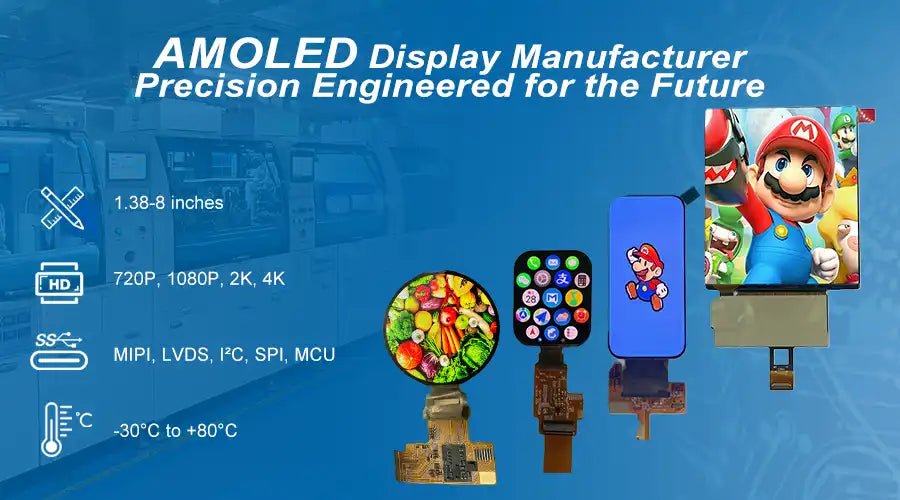Table of Contents
- Introduction
- What is OLED Display?
- What is IPS Display?
- Key Differences Between OLED and IPS
- Advantages of OLED
- Advantages of IPS
- Applications of OLED and IPS Displays
- Which Display is Better?
- FAQ
- Conclusion
Introduction
Choosing the right display technology is crucial for monitors, laptops, advertising screens, and industrial applications. Two of the most popular options today are OLED (Organic Light Emitting Diode) and IPS (In-Plane Switching) LCD. Each has its own strengths and weaknesses, and understanding these can help you select the best display for your business needs.
What is OLED Display?
OLED displays use organic materials that emit light when an electric current passes through. Unlike traditional LCDs, OLED does not require a backlight — each pixel generates its own light. This enables true blacks, infinite contrast ratios, vibrant colors, and ultra-thin, flexible panel designs.
Key features of OLED:
- Self-emissive pixels (no backlight needed)
- Perfect black levels and high contrast
- Fast response time (ideal for motion)
- Thinner, lighter, and bendable form factors
- Energy efficient with dark content

What is IPS Display?
IPS is an advanced type of LCD panel technology known for superior color accuracy and wide viewing angles compared to older TN panels. It uses a backlight and aligns liquid crystals in-plane to control light transmission.
Key features of IPS:
- Excellent color reproduction and consistency
- Wide viewing angles (up to 178°)
- No risk of burn-in
- Longer lifespan and stable performance
- Cost-effective for mass deployment

Key Differences Between OLED and IPS
| Feature | OLED | IPS |
|---|---|---|
| Backlight | No (self-emissive) | Yes (required) |
| Contrast Ratio | Infinite (true black) | Limited (grayish blacks) |
| Viewing Angles | Excellent, minimal color shift | Very good, slight shift at extremes |
| Response Time | Ultra-fast (~0.1ms) | Slower (~5–10ms) |
| Panel Thickness | Very thin, flexible options | Thicker due to backlight |
| Lifespan & Burn-in | Risk of burn-in over time | No burn-in; longer lifespan |
| Price | Higher cost | More affordable |
Advantages of OLED
- Infinite contrast ratio with true black levels
- Rich, vibrant, and accurate color reproduction
- Near-instantaneous response time (ideal for video and gaming)
- Ultra-slim and lightweight designs; supports curved/flexible panels
- Lower power consumption when displaying dark content
Advantages of IPS
- Consistent color accuracy across wide angles
- No risk of image retention or burn-in
- Long-term reliability in 24/7 operation environments
- Better performance under bright ambient lighting
- Lower total cost of ownership for large-scale deployments
Applications of OLED and IPS Displays
OLED Applications
- Premium monitors for graphic design, video editing, and gaming
- Digital signage and advertising LCDs with eye-catching visuals
- High-end laptops and portable devices
- Medical imaging systems requiring high contrast
- Industrial HMIs where thinness and clarity matter
IPS Applications
- Office monitors and enterprise laptops
- Professional photo and print color calibration
- Education and classroom displays
- Industrial control panels with long operational life
- Budget-friendly public information kiosks
Which Display is Better?
The answer depends on your application:
Choose OLED if: You need the highest image quality, deep blacks, fast refresh rates, and sleek design — ideal for advertising displays, high-end monitors, and premium consumer electronics.
Choose IPS if: You prioritize color accuracy, durability, cost-efficiency, and resistance to burn-in — perfect for office environments, educational institutions, and industrial applications running continuously.
For businesses offering OLED display modules, custom LCD solutions, or industrial screens, this comparison helps guide clients toward the optimal technology.

Frequently Asked Questions (FAQ)
What does OLED stand for?
OLED stands for Organic Light Emitting Diode. Each pixel emits its own light, eliminating the need for a backlight.
Do OLED displays have burn-in issues?
Yes, prolonged display of static images may cause temporary image retention or permanent burn-in. This is less common in IPS panels.
Is OLED better than IPS for advertising screens?
Yes, OLED offers superior brightness, contrast, and color vibrancy, making it ideal for digital signage and retail displays.
Which is better for color-critical work?
IPS is often preferred for professional photo/video editing due to its consistent color accuracy and stability over time.
Are IPS displays still relevant?
Absolutely. IPS remains a reliable, cost-effective solution for everyday use, especially where longevity and budget are key factors.
Conclusion
Both OLED and IPS display technologies serve important roles in today’s market. OLED excels in visual performance, contrast, and design flexibility — making it ideal for high-end monitors, advertising LCD panels, and innovative display solutions. IPS delivers excellent color accuracy, durability, and value — perfect for business, education, and industrial applications.
By understanding the differences, you can make informed decisions when selecting display panels for your products or projects. Whether you're sourcing TFT LCD, OLED, or advertisement LCD solutions, choosing the right technology enhances user experience and product value.





Leave a comment
Este site está protegido pela Política de privacidade da hCaptcha e da hCaptcha e aplicam-se os Termos de serviço das mesmas.